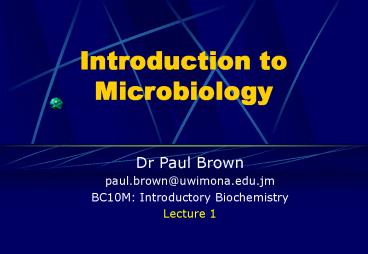Introduction to Microbiology - PowerPoint PPT Presentation
1 / 21
Title:
Introduction to Microbiology
Description:
Describe basic and specialised microscopy techniques and their applications ... Mycology: study of fungi. Immunology: study of immunity ... – PowerPoint PPT presentation
Number of Views:787
Avg rating:3.0/5.0
Title: Introduction to Microbiology
1
Introduction to Microbiology
- Dr Paul Brown
- paul.brown_at_uwimona.edu.jm
- BC10M Introductory Biochemistry
- Lecture 1
2
Teaching Objectives
- To give an overview of the history of
Microbiology - To introduce the following
- The extent of the microbial world
- Microscopy theory
- Fundamental and quantitative techniques
- Bacterial and viral growth characteristics
- Microbial phylogenetic and metabolic diversity
3
Learning OutcomesI
- At the end of this section, students will have an
appreciation of /or be able to - The important developments in Microbiology
- Describe basic and specialised microscopy
techniques and their applications - The extent of the microbial world
- Describe the important differences between
prokaryotes (Bacteria and Archaea) and eukaryotes
4
Learning OutcomesII
- At the end of this section, students should be
able to - Describe basic and specialized techniques for
quantifying microbial growth - Summarize the process of bacterial and viral
reproduction and describe the dynamics of a
bacterial growth curve and the plaque assay - Indicate how bacteria are divided into groups
according to their phylogeny /or metabolism
5
Lecture Plan
- Scope of Microbiology
- Extent of the microbial world
- History of Microbiology
- Techniques
- Microscopy and Staining
- Pure culture methods
- Quantitative methods
- Microbial growth curve
- Plaque assay
- Microbial diversity
- Phylogeny
- Substrate utilization
6
References
- Madigan et al. Brocks Biology of Microorganisms
9th, 10th eds. - Prescott et al., Microbiology, 3rd, 4th eds.
- Black, Microbiology, 4th ed.
- Other Microbiology texts
7
Introduction
- microbiology - the study of microorganisms
- organisms to small to be seen with the naked eye
- except in large groups
- effects of large numbers often visible
- e.g., chemical reactions in soil horizons
- e.g., toxin and gas production in incompletely
sterilised food cans - e.g., disease in animals and plants
8
Microbial World
- Viruses
- Bacteria (Eubacteria) and Archaeabacteria
- Fungi (Yeasts and Molds)
- Protozoa
- Microscopic Algae
9
Benefits
- Maintain balance of environment (microbial
ecology) - Basis of food chain
- Nitrogen fixation
- Photosynthesis
- Digestion, synthesis of vitamins
- Manufacture of food and drink
10
Benefits
- Genetic engineering
- Synthesis of chemical products
- Recycling sewage
- Bioremediation use microbes to remove toxins
(oil spills) - Use of microbes to control crop pests
- Normal microbiota
11
Harmful Effects
- Cause disease (basis for bioterrorism)
- Food spoilage
12
Pioneers of Microbiology
- Robert Hooke, UK (1665)
- Proposed the Cell Theory
- Observed cork with crude microscope
- All living things are composed of cells
- Spontaneous generation
- Some forms of life could arise spontaneously from
non-living matter - Francesco Redi, IT (1668)
- Redis experiments first to dispprove S.G.
13
Pioneers of Microbiology
- Antoni van Leeuwenhoek, DE (1673)
- First observed live microorganisms (animalcules)
- Schleiden and Schwann, DE
- Formulated Cell Theory cells are the fundamental
units of life and carry out all the basic
functions of living things - Pasteur, FR and Tyndall, UK (1861)
- Finally disproved S.G.
14
Pioneers of Microbiology
- Louis Pasteur (1822-1895), Chemist
- Fermentation (1857)
- Pasteurization heat liquid enough to kill
spoilage bacteria (1864) - Vaccine development rabies
- Proposed the germ theory of disease
- Proposed aseptic techniques (prevent
contamination by unwanted microbes) - Director of Pasteur Institute, Paris (1894)
15
Pioneers of Microbiology
- Joseph Lister, UK (1867)
- Used phenol (carbolic acid) to disinfect wounds
- First aseptic technique in surgery
- Robert Koch, DE (1876)
- Postulates Germ theory (1876)
- Identified microbes that caused anthrax (1876),
tuberculosis (1882) and cholera (1883) - Developed microbiological media streak plates
for pure culture (1881)
16
Kochs Postulates
- The specific causative agent must be found in
every case of the disease. - The disease organism must be isolated from the
lesions of the infected case and maintained in
pure culture. - The pure culture, inoculated into a susceptible
or experimental animal, should produce the
symptoms of the disease. - The same bacterium should be re-isolated in pure
culture from the intentionally infected animal.
17
Branches of Microbiology
- Bacteriology study of bacteria
- Mycology study of fungi
- Immunology study of immunity
- Edward Jenner, UK developed vaccination (1798)
- Metchnikoff, RU discovered phagocytes (1884)
- Paul Ehrlich, DE theory of immunity (1890)
- Virology study of viruses
- Beijerinck, NE discovered intracellular
reproduction of TMV coined the term virus
(1899)
18
Branches of Microbiology
- Parasitology study of protozoa and parasitic
worms - Chemotherapy
- Treatment of disease by using chemical means
- Antibiotics produced naturally
- Synthetic drugs
- Paul Ehrlich (1878) used arsenic compounds to
fight disease magic bullet
19
Branches of Microbiology
- Chemotherapy
- Alexander Fleming, Scotland (1928) discovered
penicillin - Selman Waksman, Ukraine (1944) discovered
streptomycin - Problems
- Toxicity of drugs gt Selective toxicity
- Resistance of bacteria to drugs
20
Branches of Microbiology
- Recombinant DNA Technology
- Recombinant DNA
- Genetic engineering/biotechnology
- Microbial genetics mechanism by which microbes
inherit genes - Molecular biology structure and function
(expression) of genes - Molecular epidemiology/diagnostics
21
Branches of Microbiology
- Biotechnology
- GMOs/GEMs for industrial, pharmaceutical and
agricultural applications - Improvements of agriculture (plants and animals)
- Gene therapy inserting a missing gene or
replacing a defective one in human cells































